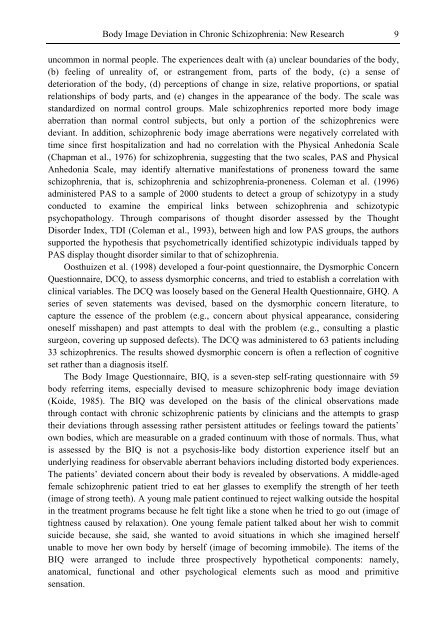Schizophrenia Research Trends
Schizophrenia Research Trends
Schizophrenia Research Trends
- No tags were found...
You also want an ePaper? Increase the reach of your titles
YUMPU automatically turns print PDFs into web optimized ePapers that Google loves.
Body Image Deviation in Chronic <strong>Schizophrenia</strong>: New <strong>Research</strong> 9uncommon in normal people. The experiences dealt with (a) unclear boundaries of the body,(b) feeling of unreality of, or estrangement from, parts of the body, (c) a sense ofdeterioration of the body, (d) perceptions of change in size, relative proportions, or spatialrelationships of body parts, and (e) changes in the appearance of the body. The scale wasstandardized on normal control groups. Male schizophrenics reported more body imageaberration than normal control subjects, but only a portion of the schizophrenics weredeviant. In addition, schizophrenic body image aberrations were negatively correlated withtime since first hospitalization and had no correlation with the Physical Anhedonia Scale(Chapman et al., 1976) for schizophrenia, suggesting that the two scales, PAS and PhysicalAnhedonia Scale, may identify alternative manifestations of proneness toward the sameschizophrenia, that is, schizophrenia and schizophrenia-proneness. Coleman et al. (1996)administered PAS to a sample of 2000 students to detect a group of schizotypy in a studyconducted to examine the empirical links between schizophrenia and schizotypicpsychopathology. Through comparisons of thought disorder assessed by the ThoughtDisorder Index, TDI (Coleman et al., 1993), between high and low PAS groups, the authorssupported the hypothesis that psychometrically identified schizotypic individuals tapped byPAS display thought disorder similar to that of schizophrenia.Oosthuizen et al. (1998) developed a four-point questionnaire, the Dysmorphic ConcernQuestionnaire, DCQ, to assess dysmorphic concerns, and tried to establish a correlation withclinical variables. The DCQ was loosely based on the General Health Questionnaire, GHQ. Aseries of seven statements was devised, based on the dysmorphic concern literature, tocapture the essence of the problem (e.g., concern about physical appearance, consideringoneself misshapen) and past attempts to deal with the problem (e.g., consulting a plasticsurgeon, covering up supposed defects). The DCQ was administered to 63 patients including33 schizophrenics. The results showed dysmorphic concern is often a reflection of cognitiveset rather than a diagnosis itself.The Body Image Questionnaire, BIQ, is a seven-step self-rating questionnaire with 59body referring items, especially devised to measure schizophrenic body image deviation(Koide, 1985). The BIQ was developed on the basis of the clinical observations madethrough contact with chronic schizophrenic patients by clinicians and the attempts to grasptheir deviations through assessing rather persistent attitudes or feelings toward the patients’own bodies, which are measurable on a graded continuum with those of normals. Thus, whatis assessed by the BIQ is not a psychosis-like body distortion experience itself but anunderlying readiness for observable aberrant behaviors including distorted body experiences.The patients’ deviated concern about their body is revealed by observations. A middle-agedfemale schizophrenic patient tried to eat her glasses to exemplify the strength of her teeth(image of strong teeth). A young male patient continued to reject walking outside the hospitalin the treatment programs because he felt tight like a stone when he tried to go out (image oftightness caused by relaxation). One young female patient talked about her wish to commitsuicide because, she said, she wanted to avoid situations in which she imagined herselfunable to move her own body by herself (image of becoming immobile). The items of theBIQ were arranged to include three prospectively hypothetical components: namely,anatomical, functional and other psychological elements such as mood and primitivesensation.
















